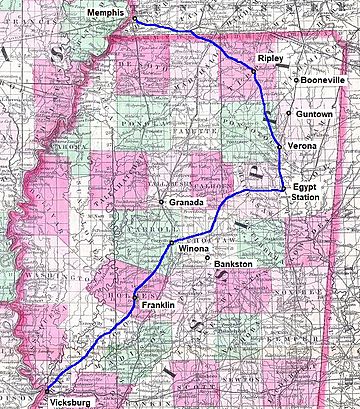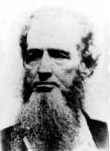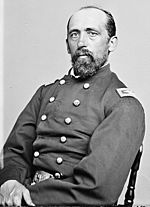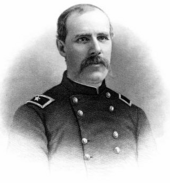Battle of Egypt Station facts for kids
Quick facts for kids Battle of Egypt Station |
|||||||
|---|---|---|---|---|---|---|---|
| Part of the American Civil War | |||||||
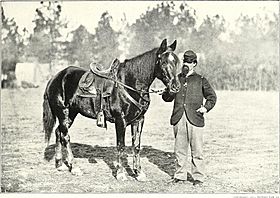 Union cavalryman |
|||||||
|
|||||||
| Belligerents | |||||||
| Commanders and leaders | |||||||
| Benjamin Grierson | Franklin Gardner Samuel J. Gholson (WIA) |
||||||
| Strength | |||||||
| 3,500 | 1,200–2,000, 4 guns | ||||||
| Casualties and losses | |||||||
| 128 | over 500 captured | ||||||
The Battle of Egypt Station happened on December 28, 1864, in Mississippi. It was a fight during a successful raid by Union cavalry (soldiers on horseback) during the American Civil War. About 3,500 Union cavalrymen, led by Benjamin Grierson, defeated Confederate troops. The Confederates were commanded by Franklin Gardner and Samuel J. Gholson.
Grierson's cavalry started their raid from Memphis, Tennessee, on December 21. First, they destroyed a Confederate supply center at Verona. As they moved south, they wrecked bridges and railroad tracks belonging to the Mobile and Ohio Railroad. The Union raiders then met Confederate defenders at Egypt Station. After winning this battle, Grierson's cavalry continued southwest to Vicksburg, arriving on January 5, 1865. The raiders destroyed many Confederate supplies and also damaged the Mississippi Central Railroad. Some captured Confederates were actually former Union soldiers who had joined the South to avoid prison. This raid made it hard for the Confederate army to get supplies after a big battle.
Contents
Why This Battle Happened
The Battle of Nashville ended on December 16, 1864. The Confederate army, led by General John Bell Hood, was badly beaten by the Union army. Hood's army had to retreat (fall back) into northern Mississippi. The Union army, led by George Henry Thomas, chased them.
To make it even harder for the Confederates, Union leaders wanted to destroy their supply lines. This is where Brigadier General Benjamin Grierson and his cavalry came in. Their mission was to break the important Mobile and Ohio Railroad. This railroad was key for the Confederates to move troops and supplies.
Destroying Supplies at Verona
On December 21, 1864, Grierson's cavalry left Memphis. They had about 3,500 men, including 11 cavalry regiments. They carried 20 days' worth of food on pack mules. They didn't have any large cannons or wagons, which helped them move quickly.
As they rode, some of Grierson's troops went ahead to damage the Mobile and Ohio Railroad at other spots. They destroyed four bridges, several miles of track, and military supplies.
Grierson's men learned that the Confederates had a large supply depot at Verona. On the night of December 25, Grierson sent Colonel Joseph Kargé's brigade to attack Verona. The Union soldiers quickly defeated the small Confederate guard. They destroyed 200 wagons filled with supplies for Hood's army. They also burned eight warehouses full of military goods, including many rifles. After setting the warehouses on fire, Kargé's brigade pulled back as shells exploded from the burning buildings.
The Fight at Egypt Station
On December 26 and 27, Grierson's division continued south along the Mobile and Ohio Railroad. They kept destroying tracks and bridges. They found out that Confederate reinforcements were coming by train from other places. Grierson decided to attack the Confederate force at Egypt Station on the morning of December 28 before these reinforcements arrived. He thought the Confederate force had between 1,200 and 2,000 men and four cannons mounted on a train.
At 7:00 am, Colonel Kargé's brigade moved forward. They pushed aside the Confederate cavalry and met a main defense line about half a mile north of Egypt Station. At 8:15 am, Kargé ordered his men to attack. The Union soldiers pushed the Confederate line back. A train with four cannons started to pull away. Kargé ordered his men to chase the train. Grierson himself joined the chase.
The Confederate defenders fell back to a wooden fort (called a stockade) next to the railroad. Union soldiers charged the stockade from both sides. The defenders soon surrendered. About 500 Confederate soldiers were captured, including several officers. During the battle, two trains carrying Confederate reinforcements arrived from the south. However, these trains were stopped and could not join the fight.
In the battle, the Union side had 27 soldiers killed and 89 wounded. The Confederates had over 500 men captured. Confederate Brigadier General Samuel J. Gholson was badly wounded and lost his left arm. After the victory, Grierson ordered his column to move west.
Continuing the Raid
From Houston, Grierson sent out smaller groups to trick the Confederates. But the main Union force marched southwest to Winona on the Mississippi Central Railroad. At Winona, they destroyed the train station, two locomotives (train engines), and more Confederate supplies.
Another group went to Bankston and destroyed factories that made cloth and shoes for Confederate soldiers. A detachment of 300 horsemen went north from Winona to Grenada, wrecking more railroad tracks and Confederate buildings.
On January 1, 1865, another Union brigade destroyed about 2.5 miles of track, bridges, and stations. The next day, near Franklin, Union cavalry ran into a Confederate force. After a fight that lasted about an hour and a half, both sides pulled back. The Union side lost a few men killed and wounded. The Confederate side also had some casualties.
Arrival at Vicksburg
Grierson's division finally rode into Vicksburg on January 5, 1865. Grierson reported that his men had destroyed a huge amount of Confederate property. This included many locomotives, railroad cars, army wagons, and miles of railroad track and telegraph lines. They also burned many warehouses full of military supplies.
The Union column was joined by about 1,000 escaped slaves. They also brought in about 600 Confederate prisoners and 800 captured horses and mules. Grierson noted that about 100 of the captured prisoners were actually Union soldiers who had been forced to join the Confederate army from Southern prison camps.
Overall, the Union forces had 27 soldiers killed, 93 wounded, and 7 missing during the entire raid.
This raid had a big impact. When General Hood's defeated Confederate army reached Corinth, Mississippi, they hoped to get new clothing and supplies. But Grierson's cavalry had destroyed so much of the Mobile and Ohio Railroad that there were no supplies. Hood had to order his army to retreat even further. This lack of food and equipment caused many Confederate soldiers to leave the army.



